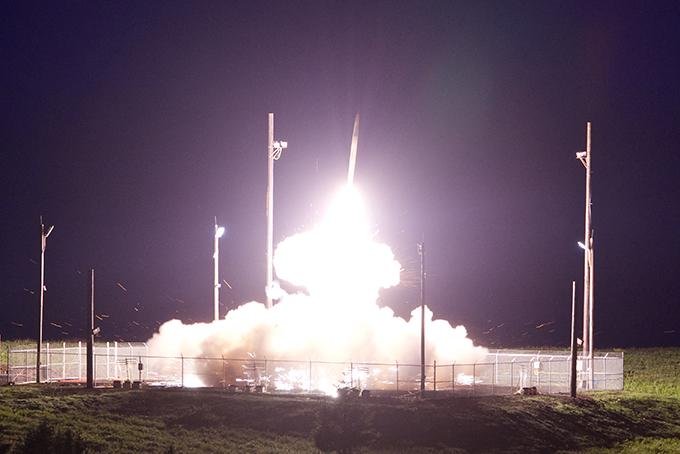Terminal High Altitude Area Defense ballistic missile interceptor being test launched. Photo courtesy of the Missile Defense Agency
Nov. 13 (UPI) -- Undersecretary of Defense for Research and Engineering, and former head of NASA, Michael Griffin told attendees at a missile defense event Tuesday that the U.S. was making good progress on directed energy weapons for missile defense, but that threats from hypersonic missiles and enemy space denial efforts still require a lot of work.
While all three areas have not been newly elevated on the list of priorities, they are at different points of research while carrying equal importance for national defense, Griffin told attendees at the CSIS Missile Defense Project on Tuesday morning.
Griffin said that though the attitude among many analysts still runs towards an axiom of "lasers are the weapon of the future and always will be," the United States has already developed lasers of military utility and will be investing heavily in scaling up laser range and power.
"In onesies and twosies we can field 10kw," Griffin said, referring to the power output of available lasers and how they can currently be fielded in small numbers.
He said that that directed energy weapons utilizing lasers or microwaves were going to be the only viable long-term countermeasure against enemy "swarm" attacks using missiles, drones and small boats.
"I see no kinetic way of doing that effectively," Griffin said in regard to conventional weapons like guns and missiles.
He said that future Department of Defense funding would reflect this priority across the services, as well as at the Missile Defense Agency. "You are going to see an increased emphasis on laser scaling across several technologies," Griffin predicted.
Griffin warned that U.S. supremacy in space surveillance could be threatened by enemy anti-satellite and space denial efforts due to assets being too concentrated in small numbers of high-value platforms.
"It is no secret the U.S. has the most sophisticated space surveillance capabilities of any nation," Griffin said, but added "these are juicy targets."
Griffin said the military needs to "disaggregate" it's capabilities into larger numbers of smaller satellites to improve resistance to attacks.
Grfffin said that above all, the U.S. must focus on keeping space accessible for all non-belligerents, much like the U.S. Navy's primary mission is maintaining freedom of navigation on the ocean.
"We need to make it clear ... the United States will maintain freedom of access to and movement in space by the U.S. and it's allies." Space assets "control how we fight on Earth. We are not as prolific in low-earth orbit as I would like us to be."
He also said that U.S. early-warning radars, satellites and interceptors are focused on detecting and countering conventional ballistic missiles, while hypersonic missiles would require different capabilities to stop.
While the U.S. has done "all the initial research" on hypersonic missiles, the decision not to weaponize it is coming back in the form of a threat from China and Russia, which Griffin said have done "dozens" of tests for the weapons.
Hypersonic missiles would operate at very high-speed in the Mach 5+ range and would operate at lower altitudes than ballistic missiles. Combining speed and evasive maneuverability, they would be very difficult to track and stop with current interceptors.
When asked by reporters about the long-awaited release of the Missile Defense Review, Griffin said he has no answers on it and that it would be up to the Trump Administration to decide when and how it would be disseminated.















